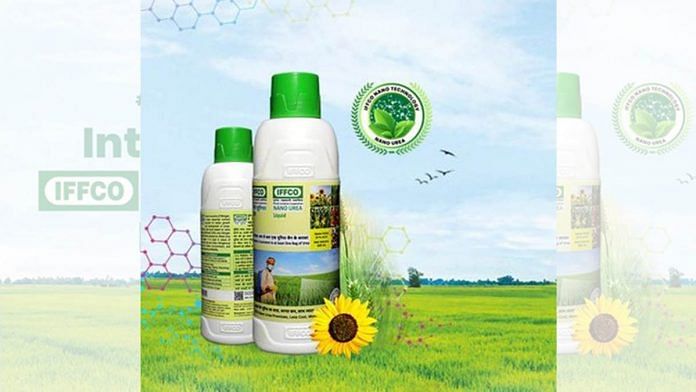New Delhi: In a development that has the potential to revolutionise the agriculture sector across the world, the Indian Farmers Fertiliser Cooperative (IFFCO) claimed Sunday it has started commercial production of ‘nano urea liquid’, a first-of-its-kind product.
The country’s largest fertiliser seller and cooperative also dispatched the product to Uttar Pradesh for use by farmers, in the first consignment from its manufacturing unit in Gujarat’s Kalol . It was developed indigenously through proprietary technology at IFFCO’s Nano Biotechnology Research Centre (NBRC) in Kalol.
This new product is expected to replace the usage of urea granules, one of the most widely used fertilisers in farmlands across the world. Conventional granular urea is one of the most important nitrogenous fertilisers in the country, with a high nitrogen content of 46 per cent, and is available at one of the lowest market prices.
Urea also forms 82 per cent of the total nitrogenous fertilisers consumed in India, with an annual consumption of 33.6 million tonnes in 2019-20.
“IFFCO Nano Urea is a product of the 21st century and it is the need of the hour to keep the environment soil, air and water, safe for future generations while securing food for all,” IFFCO vice-chairman Dilip Shangani said in a statement.
According to IFFCO, the new nano urea liquid will increase the production of crops with improved nutritional quality. Cheaper than conventional urea, the new product is also expected to reduce the environmental pollution caused by the granular form, by reducing its excessive application that exacerbates soil, water and air pollution with climate change problems.
Here’s a look at how nano urea liquid promises to radically transform farming in India and across the world by raising productivity while reducing environmental pollution and input cost.
Also read: How govt prevented a farming crisis by increasing DAP fertiliser subsidy as global prices soar
Lower usage and cost, increased productivity
On an average, a farmer in India applies two bags of urea in one acre per crop season, with the quantity varying slightly according to the crop. According to a release from IFFCO, field trials have shown that a 500 ml bottle of nano urea can replace one bag of conventional urea as it has 40,000 ppm of nitrogen, which is equivalent nitrogen nutrient provided by one bag of conventional urea.
In field trials, it was also found that nano urea is further set to replace conventional urea as it can curtail the requirement of the same by at least 50 per cent.
Also, the costing proposition of nano urea liquid should make it more favourable over conventional urea as its 500 ml bottle will be priced at Rs 240. A 45-kg bag of conventional urea costs Rs 267.
The new product will significantly bring down the cost of logistics and warehousing, IFFCO claimed.
Apart from substantially increasing farmers’ income by cutting down on input and storage cost, nano urea liquid also aims to increase crop yield and productivity against conventional urea. It is proven to increase the crop yield by an average of 8 per cent along with improving the quality of farm produce by providing better nutrition to crops, according to the coorperative.
The productivity and efficacy trials were undertaken under the National Agriculture Research System (NARS) at 20 Indian Council of Agricultural Research (ICAR) research institutes, state agricultural universities and krishi vigyan kendras (KVKs). The trials were conducted over 11,000 farmer fields on more than 94 crops across India.
Also read: MSP wheat purchase this season hits all-time high as Punjab, Haryana exceed targets
Better plant nutrition, less environmental fallout
Apart from being cost-effective, nano urea liquid also promises to provide a sustainable solution for plant nutrition as despite lower usage than its current version, it provides higher nutrient efficiency for crops while reducing soil, water and air pollution.
As of now, just 30-50 per cent of nitrogen from urea is utilised by plants in farms while the rest goes waste due to quick chemical transformation because of leaching, which contaminates soil and water bodies, and volatilisation that causes emissions of nitrous oxide in the atmosphere — leading to air pollution and global warming along with low nutritional efficiency for the crop.
However, while conventional urea is effective just for 30-50 per cent in delivering nitrogen to plants, the effectiveness of the nano urea liquid is over 80 per cent.
A major reason for this increase in efficiency is because of the fact that nanotechnology, which is the base of this new form of urea, enables designing ultra-small particles that offer higher surface-mass ratios, and help in the controlled delivery of plant nutrients.
The size of one nano urea liquid particle is 30 nanometre and compared to the conventional granular urea it has about 10,000 times more surface area to volume size. Due to the ultra-small size and surface properties, the nano urea liquid gets absorbed by plants more effectively when sprayed on their leaves.
Upon penetration, these nanoparticles reach plant parts where nitrogen is required and release nutrients in a controlled manner, thereby reducing usage while also reducing wastage into the environment.
Furthermore, aside from improving yield, soil health and nutritional quality of crop, nano urea has also been tested for biosafety and toxicity according to norms followed in India and the international guidelines developed by OECD, which are adopted and accepted globally.
Besides Kalol, the nano urea liquid will be manufactured at IFFCO’s Aonla and Phulpur plants in Uttar Pradesh, the company said. In Phase I, an annual production capacity of 14 crore bottles is being installed, which would increase to additional 18 crore bottles in Phase II by 2023. These 32 crore bottles are expected to potentially replace 13.7 million tonnes of urea by 2023.
Also read: First lockdown, then cyclone — it’s a rotten season for mango trade in Gujarat, Maharashtra



